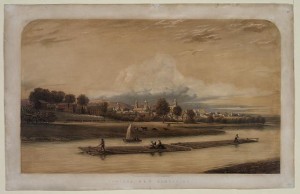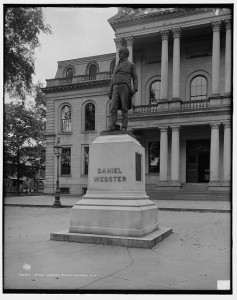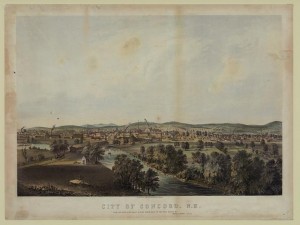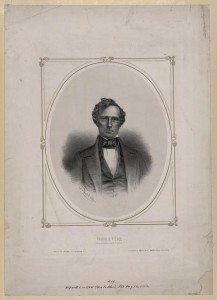There was a riot in Concord, New Hampshire on August 8, 1861. Here are a couple of views.
From the Richmond Daily Dispatch August 15, 1861:
The riot at Concord, N. H.
The telegraph yesterday announced the destruction of the office of the N. H. Democratic Standard by a mob. The following statement is furnished by the New York Post:
The riot at Concord, New Hampshire, on Thursday, briefly reported by telegraph, was a serious affair. The returned soldiers of the First New Hampshire Regiment took offence at certain expressions in the editorial columns of the Democratic Standard, a paper which has steadfastly opposed the Government and denounced the war. A company of the soldiers procured copies of the paper, read extracts to an excited crowd, and presently a revolver was fired, the ball passing into the building occupied by the Standard, narrowly escaping some women employed in a sewing machine shop on the second floor. The publishers of the Standard, four in number, thereupon appeared at the windows, armed with revolvers, guns and axes. One of them very imprudently reached forth a Colt’s revolver, shook it, and told the crowd they were well prepared, and should defend themselves to the last extremity. Those who composed the mob answered with ejaculations like the following: “Fire, you traitor”–“you rebel and secessionist”–“fire, if you dare.”
At this time the City Marshal appeared and read the riot act, and with great difficulty prevented the soldiers from ascending the stairway. John M. Hill, Esq., and several prominent citizens endeavored to calm the excited populace, but with no effect; they then went up to the office and told the publishers that if they would give up their arms they would endeavor to protect their persons and property. They agreed to this; but, before anything could be done, the soldiers were at the head of the stairs, and all parleying was at an end. The rioters attempted to enter, but the door was bolted, and they commenced staving out the panels; fire arms were then freely used inside, and several of the crowd were wounded–one in the arm, another in the hand — while bullets passed through the clothes of a number. The firing was distinctly heard in the street, and thousands filled the way to a long distance above and below the building.
The publishers escaped into the attic by a ladder, and the rioters took possession. The work of demolition was now commenced in good earnest; types, desks, paper of all kinds, and in fact everything which is used about a printing office, came tumbling down on the side walk in a fearful manner. Bonfires were immediately kiddied, and the relics of the Secession press were thrown upon the burning prier, while the soldiers gathered around the smoldering ruins and gave vent to their joy in the wildest acclamations. After the fires had somewhat abated, and nearly everything had been consumed, the City Marshal went into the office and pervaded upon the rioters to go into the street.
From The New-York Times August 12, 1861:
THE CONCORD RIOT.
We have, says the Boston Journal, a letter from another correspondent, giving an account of the destruction of the office of the Democratic Standard, in Concord, N.H., on Thursday afternoon. It gives the main features of the riot, as they have been previously stated, and adds:
“It is stated that letters were found in the office from Union men in Virginia, ‘asking them why they published such articles, and even that in that country such a paper could not live,’ &c.
Papers in abundance were found fixing unmistakably the editorialship of the obnoxious paper on EDMUND BURKE of Newport. It has always been surmised that such was the fact, but now it is conclusively shown by abundant proof. A letter was found from the editors of the New-York Day Book, asking for a list of the Democratic papers in this State, and information as to which of these papers ‘are for war, which anti-war, and which on the fence.’ These questions certainly signify something yet to be explained, but certainly no not seem to indicate on the part of the Day Book a very strong devotion to the Union. This affair has had a good effect on other parties who have openly expressed sympathy with the ‘seceshers,’ and many are ‘mum’ as can be. The Patriot came out in a bulletin stating ‘that the people were justified, in their opinion, in destroying the office of the Standard, that it ought to have been done long ago,’ &c., &c. A prominent Democrat, and one who has talked secession more or less, said it only served them right, and others say the same thing.”
The 1st New Hampshire Volunteer Infantry was a three month regiment that enlisted right after President Lincoln’s initial call for troops. It spent time with General Patterson’s army. It never got into a battle and felt the same sense of discouragement that the New York 19th felt at doing nothing to stop Joe Johnston’s rebel army from reinforcing the Confederates at Manassas. When the unit’s time was up on August 2nd, they headed back to Concord. Another account of the Concord riot is reproduced in The First Regiment New Hampshire Volunteers in the Great Rebellion by Stephen G. Abbott starting on page 172. The point of view of this account is that things only got out of hand when the people in the newspaper office started shooting.
I didn’t realize things were so violent in New Hampshire. NewHampshire.com tells of an historical marker in Fremont, which you can see at NHLiving.com:
In 1928, the Exeter News-Letter printed an eye-witness account of Fremont’s July 4, 1861 Civil War riot, written by 77-year-old Alden F. Sanborn. After Fremont’s loyal citizens raised a 150-foot ‘liberty pole’ at nearby Liberty Square and had run up the Union flag, a southern sympathizer moved to put a bullet through it. Someone immediately moved to put a bullet through that man. (A small riot ensued) which was then squelched with the aid of the brave boys in blue, one of whom remarked “If we were going to fight the rebels…we had as soon commence here as anywhere.”
Ex-President Pierce, a well-known Doughface (Southern sympathizer) lived in Concord. I wonder if he was getting a little nervous when he heard about the riot?
The paper’s editor could have been possibly named after the 19th century Irish statesman, Edmund Burke. Here’s Winston Churchill on Burke:
His soul revolted against tyranny, whether it appeared in the aspect of a domineering Monarch and a corrupt Court and Parliamentary system, or whether, mouthing the watch-words of a non-existent liberty, it towered up against him in the dictation of a brutal mob and wicked sect. No one can read the Burke of Liberty and the Burke of Authority without feeling that here was the same man pursuing the same ends, seeking the same ideals of society and Government, and defending them from assaults, now from one extreme, now from the other.
I noticed the statue of Daniel Webster in Concord. I double-checked his quote about Liberty and Union being one and inseparable and noticed another that seems somehow applicable to the Concord riot:
Liberty exists in proportion to wholesome restraint.




